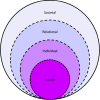A systematic scoping review on group non-written reflections in medical education
- PMID: 39390436
- PMCID: PMC11468106
- DOI: 10.1186/s12909-024-06117-3
A systematic scoping review on group non-written reflections in medical education
Abstract
Background: Medical education is tasked with shaping how medical students and physicians think, feel and act as professionals, or their Professional Identity Formation (PIF). This process has traditionally rested upon imparting knowledge; integrating sociocultural, professional and organizational expectations and codes of conduct; inculcating program and practice beliefs, values and principles (belief systems); and imbuing shared identities - quintessential elements that, together, comprise the socialization process. Key to supporting this socialization process is reflective practice. However, regnant approaches to mobilizing reflective cycles are faced with resource, personnel and time constraints, hindering efforts to nurture PIF. Group non-written reflections (GNWR) - broadly defined as facilitator-led discussions of shared reflective experiences within groups of learners - may prove to be an effective compromise. To address diverse approaches and a lack of effective understanding, we propose a systematic scoping review (SSR) to map the current use of GNWR in medical training and its role in shaping PIF.
Methods: Guided by the Systematic Evidence-Based Approach (SEBA)'s constructivist ontological and relativist epistemological position, this SSR in SEBA searched for articles on GNWR published in PubMed, Embase, Psychinfo, CINAHL, ERIC, ASSIA, SCOPUS, Google Scholar, Open Grey, GreyLit and ProQuest databases. The data found was concurrently analyzed using thematic and direct content analysis. Complementary themes and categories identified were combined, creating the domains that framed the discussion.
Results: Of the 8560 abstracts and 336 full-text articles reviewed, 98 articles were included. The four domains identified were: (1) Indications of use and their value; (2) Structure and how they can be used; (3) Models of reflective practice in GNWR; and (4) Features of communities of practice and the socialisation process.
Conclusion: This SSR in SEBA concludes that GNWR does impact PIF when effectively structured and supported. The Krishna-Pisupati Model for PIF platforms a model that explains GNWR's effects of PIF and advances fourteen recommendations to maximize GNWR use.
Keywords: Group reflection; Medical education; Medical students; Medicine; Non-written reflection; Physicians; Professional identity formation; Reflection.
© 2024. The Author(s).
Conflict of interest statement
The authors declare no competing interests.
Figures






References
-
- Barab S, Makinster J. Designing system dualities: Characterizing an online professional development community. In: Barab S, Kling R, Gray J, editors. Designing for virtual communities in the service of learninges. Cambridge, UK: Cambridge University Press; 2004. p. 53–90.
-
- Spampinato CM, Wittich CM, Beckman TJ, Cha SS, Pawlina W. “Safe harbor”: Evaluation of a professionalism case discussion intervention for the gross anatomy course. Anat Sci Educ. 2014;7(3):191–8. - PubMed
-
- Mezirow J. Transformative learning: Theory to practice. In: Cranton P, editor. Transformative learning in action: Insights from practice. 1st ed. San Francisco, CA: Jossey-Bass; 1997. p. 5–12.
-
- Kember D, Leung D, Jones A, Loke AY, McKay J, Sinclair K, et al. Development of a questionnaire to measure the level of reflective thinking. Assess Eval High Educ. 2000;25:381–95.
-
- Wittich CM, Reed DA, McDonald FS, Varkey P, Beckman TJ. Perspective: Transformative learning: a framework using critical reflection to link the improvement competencies in graduate medical education. Acad Med. 2010;85(11):1790–3. - PubMed
Publication types
MeSH terms
LinkOut - more resources
Full Text Sources

